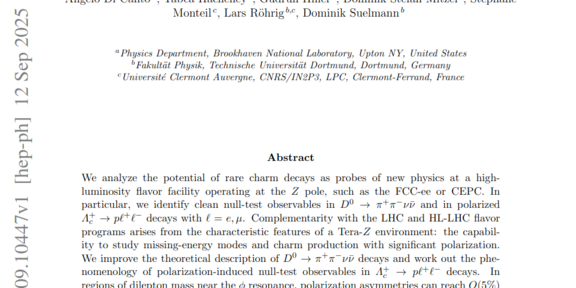New opportunities for rare charm from Z → c\bar{c} decays
- Hiller

Abstract:
We analyze the potential of rare charm decays as probes of new physics at a high-luminosity flavor facility operating at the Z pole, such as the FCC-ee or CEPC. In particular, we identify clean null-test observables in D0→π+π-νν¯and in polarized Λ+c→pℓ+ℓ-decays with ℓ=e,μ. Complementarity with the LHC and HL-LHC flavor programs arises from the characteristic features of a Tera-Z environment: the capability to study missing-energy modes and charm production with significant polarization. We improve the theoretical description of D0→π+π-νν¯decays and work out the phenomenology of polarization-induced null-test observables in Λ+c→pℓ+ℓ-decays. In regions of dilepton mass near the ϕ resonance, polarization asymmetries can reach O(5%) for muons and O(14%) for electrons times the Λ+c polarization. We also point out synergies between the dineutrino and the dilepton modes using the SMEFT framework of heavy new physics. Using the IDEA detector concept at FCC-ee, we find in simulation studies that dineutrino branching fractions as low as ∼2×10-7 can be probed, which reaches well into the parameter space of new physics, and also allows for discrimination of lepton flavor structures. Furthermore, the measurement of asymmetries in Λ+c→pμ+μ-at O(1%) will be possible. Similar sensitivities are expected for dielectron final states, although robust predictions will require further dedicated studies.
Link to the paper:

